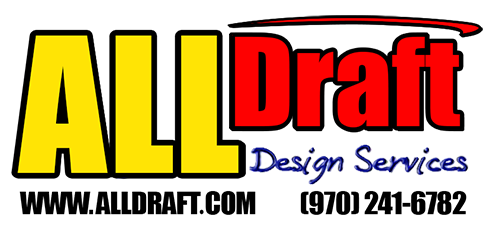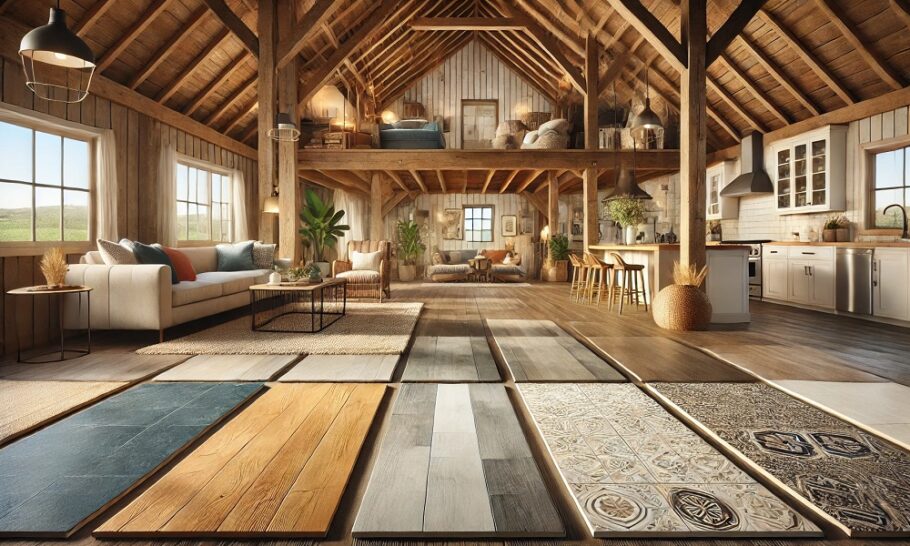Barndominiums—those modern rustic hybrids of barn and home—have exploded in popularity thanks to their flexibility, durability, and charm. Whether you’re building one from the ground up or converting an existing structure, one major decision can dramatically influence the look, comfort, and functionality of your space: the flooring.
With so many options available, it can be tough to decide what works best for your barndo lifestyle. From the sleek industrial feel of polished concrete to the cozy character of reclaimed wood, let’s explore the best (and worst) flooring choices for barndominiums—and why each one may (or may not) be right for you.
1. Polished Concrete: Industrial Chic Meets Practicality
The Good:
Polished concrete is one of the most popular barndominium flooring choices—and for good reason. Since many barndos are built on slab foundations, you’re already working with concrete. Polishing it turns that raw material into a durable, low-maintenance surface that exudes modern, industrial cool. It’s great for high-traffic areas, resists moisture, and won’t harbor allergens.
Pros:
- Extremely durable and long-lasting
- Low maintenance and easy to clean
- Moisture and stain resistant when sealed properly
- Works well with radiant heating systems
- Reflects light, brightening large open areas
The Bad:
Concrete isn’t known for comfort. It’s cold underfoot (unless heated) and unforgiving if you drop something—or take a tumble. It can also feel a bit too “sterile” in a cozy, rustic home unless softened with rugs or warm décor.
Cons:
- Hard on the joints and feet
- Cold without radiant heating
- Can crack over time
- May not appeal to everyone aesthetically
Verdict:
- Great for barndos with a modern edge or heavy use areas like workshops and kitchens.
- Not ideal if comfort or warmth is your top priority.
2. Luxury Vinyl Plank (LVP): A Strong Contender for Style and Durability
The Good:
LVP is a barndo owner’s best friend. It mimics the appearance of hardwood but is waterproof, scratch-resistant, and budget-friendly. It’s also soft underfoot compared to tile or concrete, making it a solid choice for living spaces, bedrooms, and even bathrooms.
Pros:
- Waterproof and highly durable
- Available in endless styles (wood, stone, etc.)
- Affordable compared to real hardwood or tile
- Easy to install—often a DIY job
- Warmer and softer than tile or concrete
The Bad:
While LVP is tough, it’s still a synthetic product. It may not match the depth and character of real wood for some. Cheaper brands can also fade or warp over time, especially in high heat.
Cons:
- Doesn’t add as much resale value as real wood
- Can feel a bit “plastic-y” underfoot
- Not environmentally friendly
Verdict:
- One of the best all-around choices for barndominiums—especially for families or pet owners.
- Skip it if you’re aiming for a fully authentic, all-natural interior.
3. Reclaimed Wood: Character, Charm, and Conscious Living
The Good:
Few flooring types can match the character of reclaimed wood. It offers texture, history, and that unmistakable rustic charm—perfect for barndominiums with a farmhouse or vintage design. Plus, it’s sustainable: reusing old wood keeps materials out of landfills and adds a unique story to your home.
Pros:
- Full of character and natural beauty
- Eco-friendly and sustainable
- Adds instant warmth to any space
- Increases home value and appeal
The Bad:
Reclaimed wood can be pricey and high-maintenance. If not properly treated, it may carry pests or harbor moisture. It’s also prone to scratches and dents, so it’s not ideal for households with pets, kids, or high traffic.
Cons:
- Expensive compared to other options
- Requires professional installation
- May need regular sealing or refinishing
- Can be inconsistent in color or size
Verdict:
- Ideal for rustic, vintage, or farmhouse-style barndominiums where aesthetics matter.
- Avoid if you need low-maintenance or budget-friendly solutions.
- Tile: Cool and Classic—but a Bit Cold
The Good:
Tile is durable, water-resistant, and available in a wide variety of styles, including wood-look planks that can fool even the keenest eye. It’s great for bathrooms, mudrooms, and even kitchens where spills are common.
Pros:
- Water and stain resistant
- Available in many designs and finishes
- Great for warm climates
- Easy to clean
The Bad:
Tile can be cold and hard—just like concrete. It also takes time and skill to install, and it’s prone to cracking if your barndo’s foundation shifts.
Cons:
- Can be slippery when wet
- Grout lines require maintenance
- Cold underfoot without heating
- Labor-intensive installation
Verdict:
- Works well in high-moisture areas or warm climates.
- Not the cosiest choice for living rooms or bedrooms.
5. Engineered Hardwood: Beauty Meets Stability
The Good:
Engineered hardwood offers the classic look of real wood with added stability thanks to its layered construction. It’s more resistant to moisture and temperature changes than solid hardwood, making it a smart pick for barndominiums in varied climates.
Pros:
- Real wood veneer with authentic look
- More stable than solid hardwood
- Easier to install (click-lock systems available)
- Adds value and warmth
The Bad:
Still not as durable as vinyl or tile. It can scratch or dent, and water damage is still a concern. It also costs more than LVP or laminate, though usually less than reclaimed wood.
Cons:
- Susceptible to wear and tear
- Not waterproof
- Needs refinishing over time
Verdict:
- A great compromise between natural beauty and functionality
- Less ideal for homes with high traffic or moisture-prone areas.
6. Laminate: Affordable but Limited
The Good:
Laminate flooring has improved over the years and is now available in high-quality finishes that mimic wood or stone. It’s relatively easy to install and more affordable than many other options.
Pros:
- Budget-friendly
- Easy to install
- Scratch-resistant
- Comes in a wide range of looks
The Bad:
Unlike LVP, laminate isn’t waterproof, so it’s a poor choice for bathrooms or laundry areas. It also doesn’t have the same feel or longevity as other options.
Cons:
- Not water resistant
- Feels hollow or cheap underfoot
- May not hold up over decades
Verdict:
- Fine for budget-conscious builds or short-term solutions.
- Skip it if you’re aiming for a premium, long-lasting interior.
Conclusion
There’s no one-size-fits-all when it comes to flooring in a barndominium. Your ideal choice depends on your lifestyle, budget, and design goals. Polished concrete might be perfect if you love modern minimalism and need durability. If you’re after comfort and easy upkeep, LVP is hard to beat. And if rustic charm tops your list, reclaimed wood could be your dream floor—just be ready for the upkeep.
Whatever you choose, make sure it fits not just your design vision, but the real way you live in your space. Your barndominium is a blank canvas—lay the right foundation, and everything else will fall into place.

